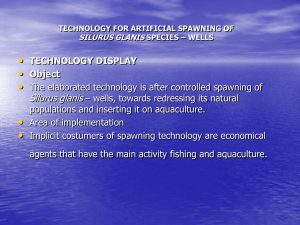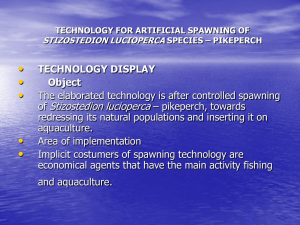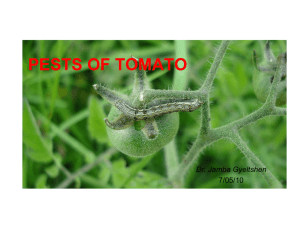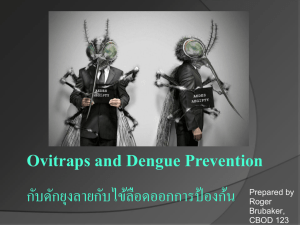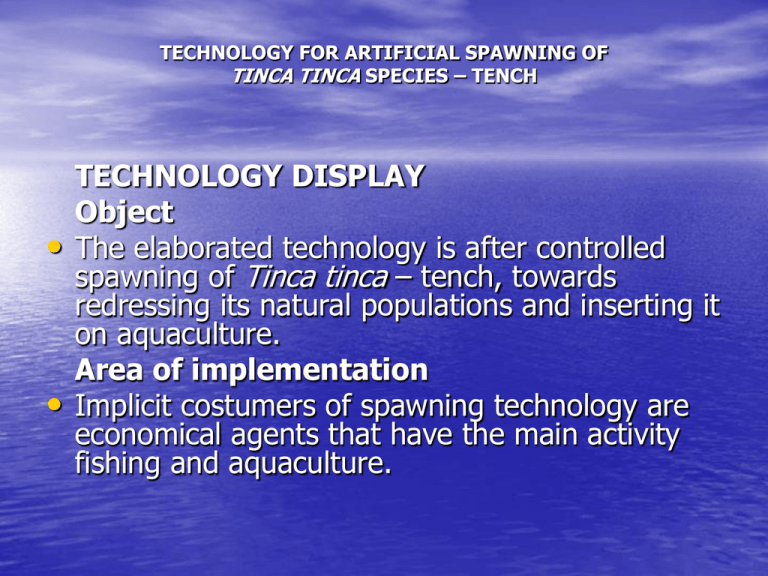
TECHNOLOGY FOR ARTIFICIAL SPAWNING OF
TINCA TINCA SPECIES – TENCH
•
•
TECHNOLOGY DISPLAY
Object
The elaborated technology is after controlled
spawning of Tinca tinca – tench, towards
redressing its natural populations and inserting it
on aquaculture.
Area of implementation
Implicit costumers of spawning technology are
economical agents that have the main activity
fishing and aquaculture.
Technological system for artificial spawning of Tinca tinca –
tench
Technological system will be apportion depending on
production capacity agreed by costumer, and will ensure by its
capacity the spawning of minimum 10 families, in order to insure
maintenance and conservation of genetic biodiversity of species.
Correlate with the capacity for incubation, technological system will
be framed by an ensemble of earthen ponds: ponds for standingwintering, ponds for pre-maturation, modules for standing and
maturation of breeders, modules for incubation of embrionated eggs
and modules for standing and growing larvae having the same
technical parameters as like as for wells.
• DESCRIPTION OF TECHNOLOGY
• The technology for artificial breeding and rearing of Tinca tinca
•
•
•
•
•
•
•
•
•
•
larvae imply the passing through of following phases:
Assurance of breeders stock;
Evaluation of phenotypic characters and sex determination;
Standing, pre-maturation of breeders;
Maturation of breeders;
Induction of sexual cells maturation;
Gathering sexual products;
Fecundation;
Incubation of sexual products in special installed enclosures;
Sacking and transportation of larvae;
Rearing larvae up to 45 days.
• Assurance of breeders stock.
Tench breeders used in artificial
spawning come from stocks
reared in farms especially for this
goal or captured from natural
environment. In autumn, breeders
are catch from rearing ponds and
populated on wintering ponds.
Most times, tench breeders are
wintering together with other
cyprinids. For establishment of
breeders stock are chosen fish
with age of 3 – 6 years and
weight of 0.8 – 2.0 kg.
• Evaluation of phenotypic characters and sex determination
• Tench breeders are catch from wintering ponds and separated
depending on sex when water temperature attains 15 – 18 0C.
Separation on sexes is accomplish easily, breeders exhibiting a
pronounced sex dimorphism: male display an acute development of
pelvic belt and of fins from this level, with bowing and bodying up
on a part of fins, and also males are bigger than females.
• For artificial spawning are used breeders having average body
weight between 800 – 1500 g/ex on females and between 1500 –
2000 g/ex on males.
• Breeders are hold in maturation ponds up on the moment when
water temperature attain and remain around the value of 22 – 24
0C and don’t fell under 19 – 20 0C in the night.
• Induction of sexual cells maturation
• When water temperature is maintain around 22 0C, breeders, mails
•
•
•
•
•
•
and females are catch from maturation ponds and stock in standing
modules from incubation station.
Hormonal treatment goes through after 24 hours from stocking of
breeders in the station for incubation. For induction of sexual cells
maturation on tench, it is used carp pituitary. The total dose is of
10 mg/kg of body weight on females and 6 mg/kg of body weight
on males.
Males are stimulated with a single dose of 6 mg/kg body weight.
Hormonal induction of females is made in two steps:
Step I – 3 – 4 mg/kg of female body weight;
Step II – 6 – 7 mg/kg of female body weight.
Injection is applied within the peritoneum. On temperatures of 23 –
25 0C, breeders are injected in the evening time, dealing the first
dose on females and entirely amount of hormone on males. The
second dose on females is deal at an interval of 8 – 10 hours.
• Gathering eggs and artificial fertilization.
• Gathering eggs is made by gently palpation of abdomen.
• Females release the eggs in one or more portions. From one female
are gathering between 50 and 150 g of eggs. After gathering eggs,
one gram of eggs are weight and then counter to determine
absolutely fecundity (number of eggs / female) and relative
fecundity (number of eggs / kg of female). One gram coincides with
about 1400 eggs.
• The same proceed with males; sperm is gathered in a crystallizer by
abdominal palpation or by using a syringe with tygon tube of 5-6 cm
long. The tube is placed slowly in the urogenital outlet. At the
exemplars whereat the permeation is complete, sperm start to flow
on syringe when primer is move back.
• Volumetrically, the average quantity of gathered sperm is of 2.0 –
2.5 ml/kg of body weight.
• Artificial fecundation
• Eggs gained from each female
are fertilize with a mixture of
sperm from more males. For
fertilization of 100 g of eggs
are required 2 ml of sperm.
Fertilization is made by dry
method. Sperm is dispersing
on eggs, after that, the
mixture is homogenized for
about 2 minutes. The fertilized
eggs are spread on frames and
after another 5 minutes,
fertilized eggs are bringing in
Nucet hatcheries for
incubation.
• Incubation of sexual products
• Incubation of eggs will start with
•
•
introduction and attach of frames
in the Nucet hatcheries.
Incubation lasts 2 – 3 days at the
temperature of 23 – 25 0C.
For tench, optimal temperature for
hatch is 23 – 25 0C.
During embryogenesis the flow of
water supply for incubation
enclosures will be correlated with
physiological necessities of
embryo in its different
development phases.
• Sampling and standing of larvae
• Sampling of hatched larvae is made continuously on
•
•
cushion of water, in individual tanks for gathering.
Gathering tank is fitted with a nytal cage having mesh
size of 0.2 mm to constrict the larvae.
The constricted larvae are sample with a standard
measure and placed in other clean hatcheries, where are
hold up on the resorption of vitelline bag, about 5 days
at 24 – 25 0C.
Stocking density will be of 20 – 25.000 ex/incubator.
Water flow in tanks for standing of larvae will be
adjusted to 5 l/min.
• Growth of larvae up on achieving adult-like phenotypic characters
• Stoking rate
• Larvae achieved from each female are stoked independently on rearing
•
•
•
•
•
•
•
enclosures.
Stoking rate is 10.000 ex/m3 and is determined taking into account
technological losses for rearing phase which in general are estimated on 30
%.
Preparing of rearing modules and stoking of larvae.
Preparing of rearing enclosures is made with 48 hours afore stoking.
Enclosures are rigorously cleaned with Germostop solution 10 %, this
solution is keep on for an hour and then banished by repeated wash off.
The height of water column in rearing enclosures is adjusted to 20 cm.
Technological water from enclosures will be assessing physic-chemically by
determination of temperature, pH and oxygen.
The flow of water supply in enclosures for pre-maturation is set at 5 – 7
l/min.
• Feeding
• Rearing of larvae up to outlining phenotypic characters conformable with adults is
•
•
•
•
•
•
•
•
•
•
achieved on account of a feeding schedule involving deliver of live food and blended
yolk of egg in first 5 – 7 days of growth and then a composite diet composed of
natural food and forage.
Feeding with natural food is achieved with very small zooplankton. The diet is supply
with blended yolk of egg.
Feeding of larvae using natural live food in a composite diet with forage will imply the
use of following feeding schedule that will allow gradually passing to a feeding based
exclusively on forage:
first 5 days: 85 % zooplankton, 15 % forage;
next 5 days: 60 % zooplankton, 40 % forage;
next 5 days: 50 % zooplankton, 50 % forage;
next 5 days: 10 % zooplankton, 90 % forage.
After that feeding will be assure only by forage.
With the passage exclusively on forage, daily ration will be determined depending on
consumption, percentage ranging from 4 to 20 % of batch weight.
For tench rearing shall be used carp feeds with a content of crude protein ranging
from 35 to 45 % and granulation of 0.1 – 0.2 mm. Feeds shell be delivered in 8 – 10
meals per day.
The growth gain that has to be achieved after 30 days, up to outlining of adult-like
phenotypic characters, is 300 – 500 mg/ex.
• Terms of maintenance on rearing time
• On the rearing enclosures must be keep a severe sanitation. The sanitation
will be achieved before every feeding and will consist of removing
excrements and any offal of feeds from the last meal. At least once every
24 hours to clean the walls of rearing enclosure through rubbing them with
a sponge flooded in a solution of potassium permanganate with a
concentration of 23 mg/l. Also can be used methylene blue on a
concentration of 1 %.

